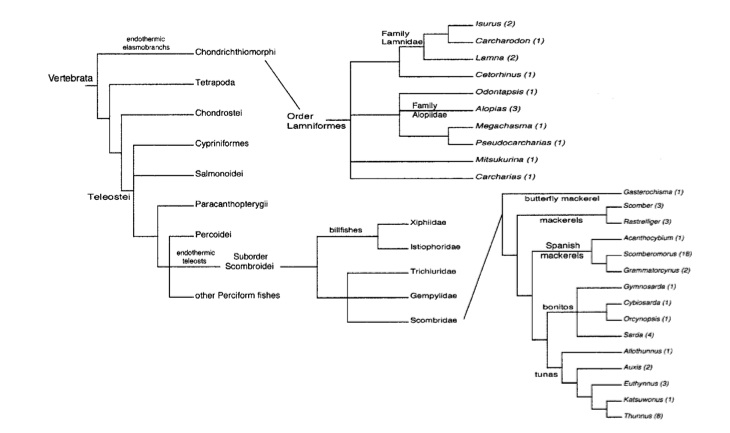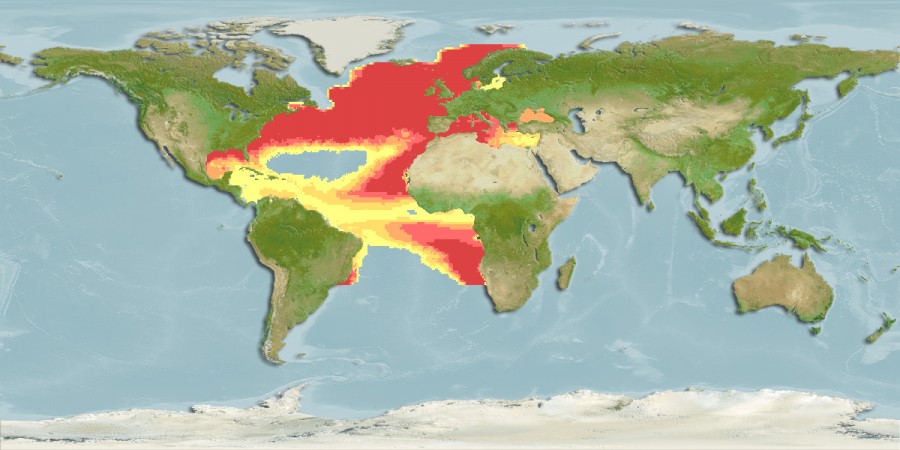Bluefin Tuna
 Biology 342 Fall 2010
Biology 342 Fall 2010
Lucy Sudekum and Colin Townes-Anderson
Phylogeny
Origins of the Bluefin Tuna
The bluefin tuna originated from an exothermic ancestor. Earliest tuna fossils have been found in the late Paleocene (55-65 Ma) or Early Eocene (50-55 Ma) epochs of the Tetiary and have been found in the Tethys Sea deposits from the Middle East, southern Europe and the London clay formation. The earliest bonito, a close relative of the tuna (see Phylogeny tree), has been identified as the Sarda palaeocenica from the Early Paleocene. The extinct Paleothunnus parvidentatus displayed characteristics common to both the tuna and the bonito, suggesting that the split of the tuna and bonito did not occur until the Early Eocene. Within 8-10 million years the two species diverged, forming the genus Thunnus (Dickson and Graham).

Figure 1. Phylogeny tree of relationships between endothermic fish species (Dickson and Graham). Numbers in parentheses represent the number of species in the genus. Bluefin tuna are located within the family Scombridae which contains 15 other genera of bonito, tunas and mackerels. The tunas account for 5 different genera. The bluefin tuna is located under the genus name "Thunnus" (found at the bottom of the tree). Its closest related genus is "Katsuwonus" or otherwise known as the oceanic bonito or skip-jack tuna.
Origins of Endothermy and Migration
As the oceans began to cool, warm waters began to compress into the tropics. In the Cenozoic period, waters were the warmest at the end of Paleocene. The Tethys Seaway, a large tropical sea, began to shrink due to tectonic events and contributed to ocean cooling across the planet. Endothermy possibly evolved in tunas as a result of the need for migration and diving in colder waters for plentiful hunting grounds.
Two modes of endothermy have evolved in the suborder Scombroidei- Tunas (including the bluefin, Scombridae family) warm their muscle, viscera and brain by retaining metabolic heat created by these mucles through vascular counter-current heat exchanges. Billfishes (found in the Xiphildae and Istiophoridae families) warm only the brain and retina in the form of cranial endothermy. Butterfly mackerel (found in family Scombridae) also possesses heater organs similar to the billfishes. Block and Finnerity (1994) conclude that endothermy has evolved three time within the suborder Scombroidei- once in billfishes, once in the Gasterochisma lineage, and once in the tuna. However, considering that the tuna is able to warm itself in different locations in its body, it is possible that this trait has arisen out of several independent evolutionary events due to selection pressures.
Because of evolution of endothermy within the bluefin tuna, the fish are able to migrate across large distances. Dickson and Graham state that this "has enabled [the Atlantic nothern bluefin tuna] to greatly expand [its] range and take advantage of the rich feeding areas in nothern waters and warm spawning areas in the tropics", effectively expanding its thermal niche.
Figure 1. Distribution of Atlantic bluefin tuna. It has a diverse area for hunting and spawning, usually hunting in colder waters while mating and spawning in warmer waters.
